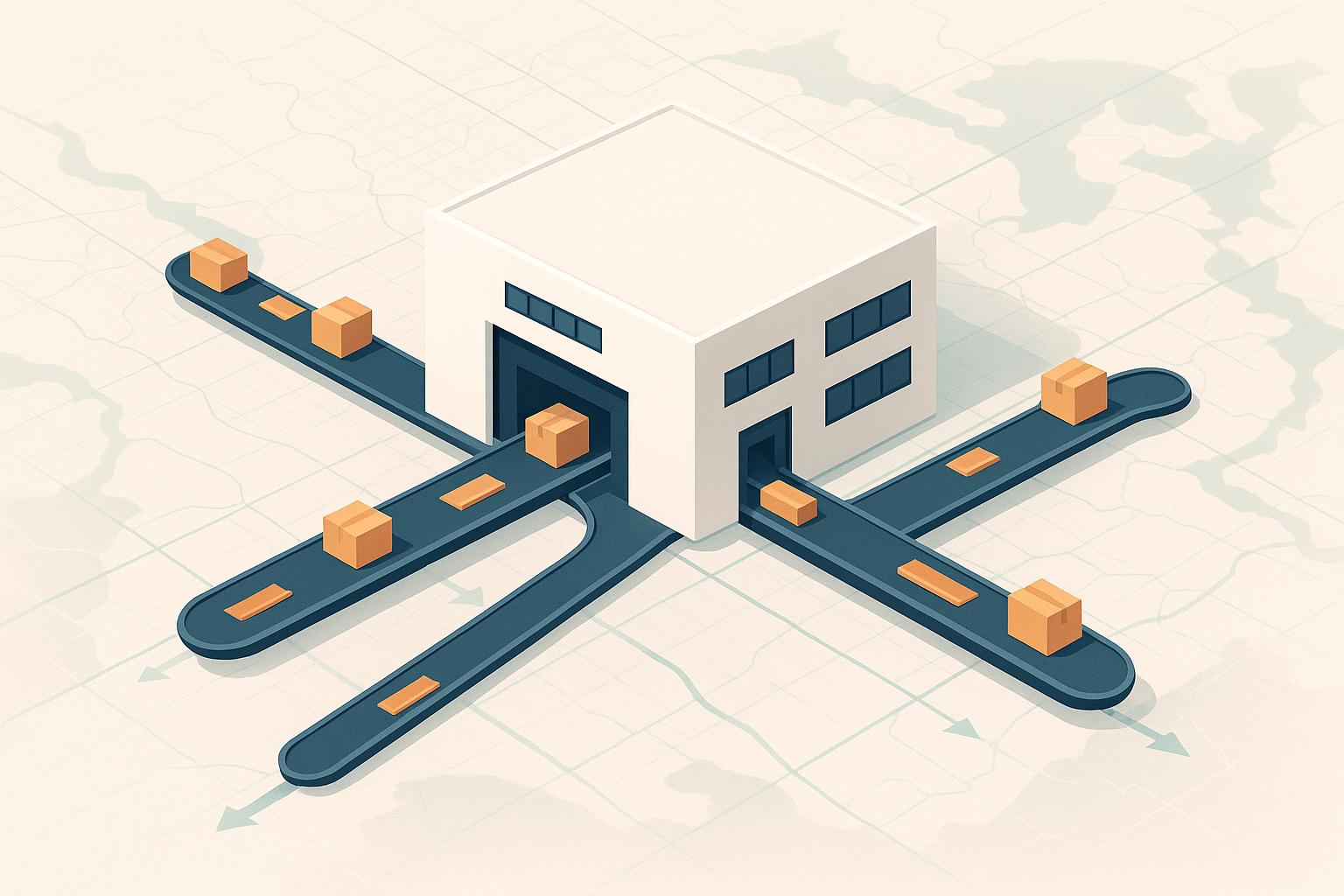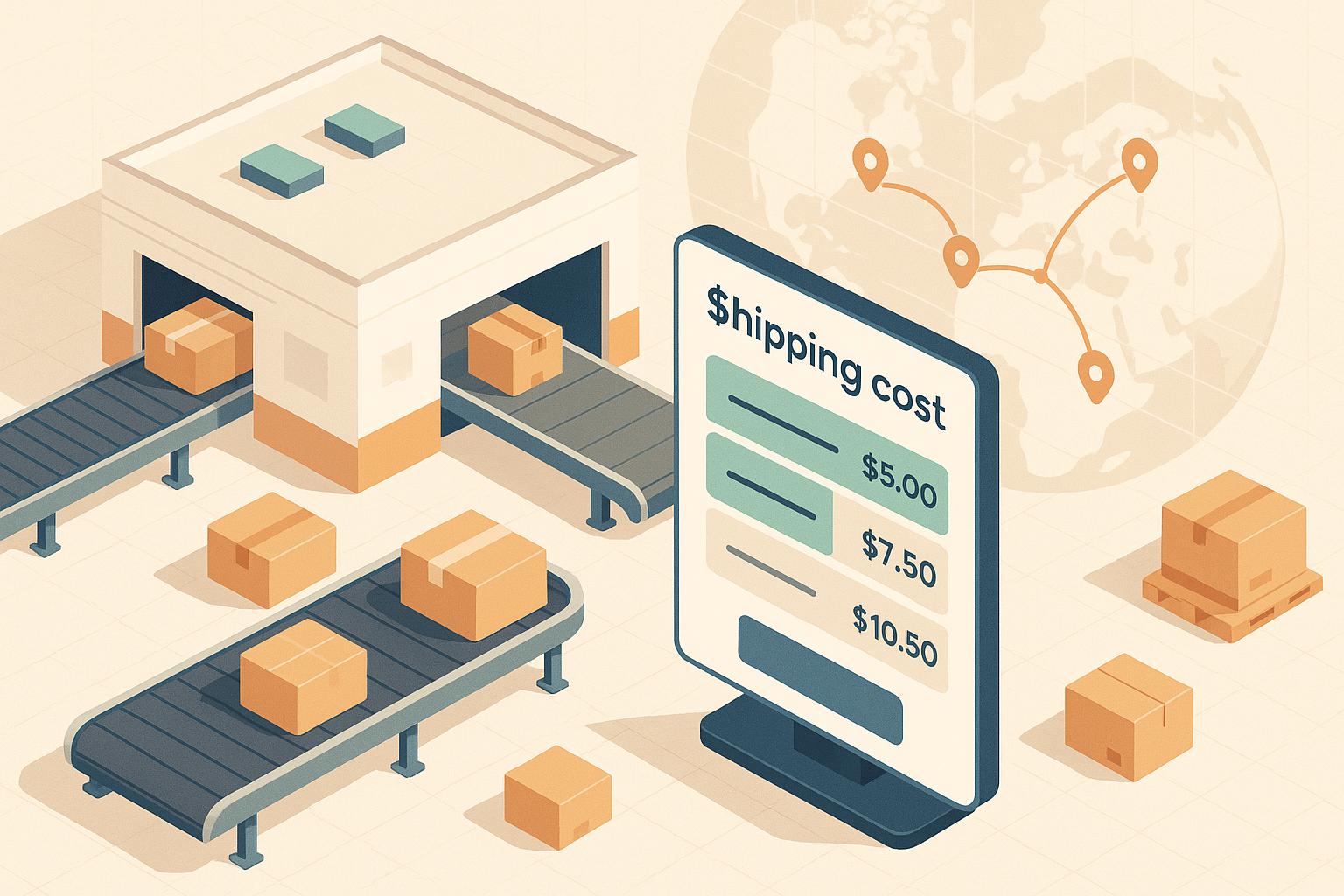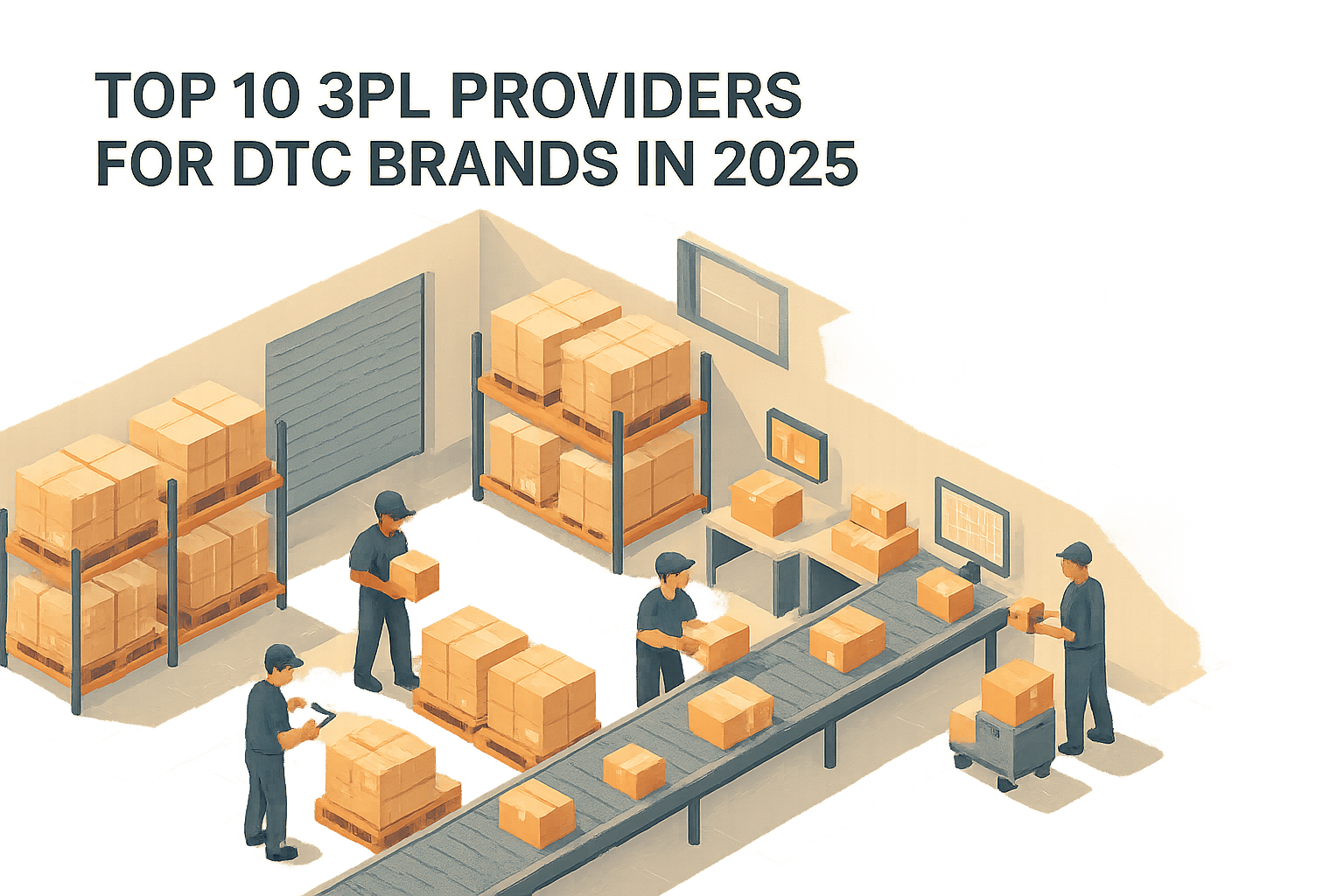Tech integrations with 3PL providers are critical for eCommerce brands looking to improve fulfillment efficiency, reduce costs, and boost customer satisfaction. Here’s what you need to know:
- Shopify Integration: Automates order processing, inventory syncing, and tax compliance. Supports major U.S. carriers like USPS, UPS, and FedEx.
- WooCommerce Integration: Tailored for WordPress stores, it offers flexibility with plugins for real-time inventory updates and shipping automation.
- Amazon Marketplace Integration: Leverages Amazon's fulfillment network for multi-channel operations, ensuring fast and reliable deliveries.
- Shipping Carrier Integrations: Centralizes carrier options (USPS, FedEx, UPS) for rate comparisons, automated label generation, and real-time tracking.
- EDI Integration: Automates data exchange for purchase orders, shipping notices, and inventory updates, meeting U.S. compliance standards.
- Real-Time Inventory Platforms: Provides live stock updates and demand forecasting, reducing stockouts and improving order accuracy.
- Forthmatch Integration: Simplifies finding the right 3PL provider with tools like service area mapping and direct connections.
Quick Comparison:
| Integration Type | Key Features | Best For |
|---|---|---|
| Shopify | Automated order/inventory sync, U.S. tax compliance | Small to medium eCommerce brands |
| WooCommerce | Customizable plugins, carrier APIs | WordPress-based stores |
| Amazon Marketplace | Multi-channel fulfillment, fast delivery | Amazon sellers, multi-platform brands |
| Shipping Carrier Integrations | Rate shopping, real-time tracking | High-volume shippers |
| EDI | Bulk order processing, compliance | Enterprise-level operations |
| Real-Time Inventory Platforms | Live updates, multi-location visibility | Inventory-heavy businesses |
| Forthmatch | 3PL discovery, service area mapping | Brands seeking new 3PL partners |
These integrations help you streamline processes, cut costs, and improve customer experiences. Choose the ones that align with your platform and growth goals.
What should I connect my 3PL to? eCommerce or Inventory/ERP System
1. Shopify Integration

Seamlessly connecting your online store to a fulfillment system is critical for streamlining operations, and Shopify's integration with 3PL platforms makes this process effortless. When a customer places an order on your Shopify store, the details are instantly sent to your 3PL provider. From there, the 3PL handles the picking, packing, and shipping through its network of fulfillment centers - no manual input required. This automated process not only reduces errors but also saves time and resources, laying the groundwork for growth and cost efficiency.
Ben from Easyship sums it up well:
"Shopify 3PL integration is an integration that allows Shopify merchants to connect with third party service providers to outsource their logistics tasks and actions to free them up for core operations as well as improving efficiency."
Key US-Specific Features
For eCommerce brands operating in the United States, Shopify's 3PL integrations tackle critical logistical challenges. The platform supports all major US shipping carriers - USPS, UPS, FedEx, and DHL Express - ensuring fast and cost-effective delivery across the country. This flexibility allows merchants to choose the best carrier for every order.
Tax compliance is another major win. Shopify integrates with tools like Avalara and Vertex, which automatically calculate sales tax for different states and jurisdictions. For international orders, Shopify's Duties & Import Taxes calculator ensures accurate cost estimates, factoring in the US de minimis threshold of $800 USD.
Real-World Benefits of Integration
The impact of Shopify-3PL integration is tangible. Take Oak + Fort, for example: by unifying their inventory management system, they saved 50 hours of staff time each week and reduced operating costs by 47%.
Scaling Made Simple
Shopify's Fulfillment Orders API is a game-changer for scaling your business. It automates key processes like routing orders, syncing inventory in real-time, and sending customer notifications. This allows businesses to grow without adding unnecessary operational complexity.
To maximize the benefits, choose a 3PL partner that offers real-time inventory updates, transparent order tracking, and strategically located warehouses . With 62% of customers expecting delivery within three days and the 3PL market predicted to hit $1.59 trillion by 2028, integrating Shopify with a reliable 3PL isn't just a smart move - it’s essential for staying competitive in today’s fast-paced market. These features make Shopify integration a cornerstone for any business aiming to scale efficiently.
2. WooCommerce Integration
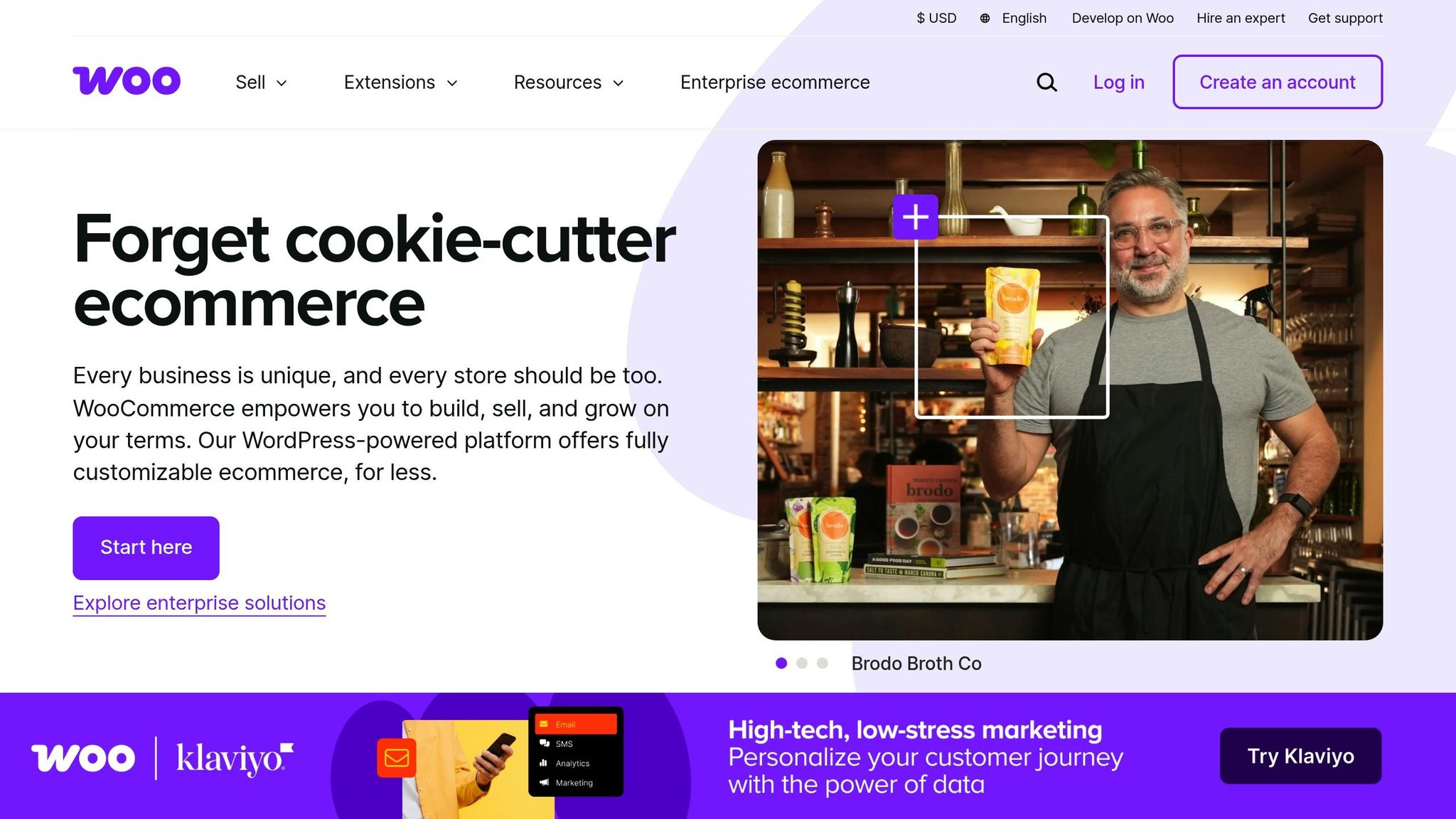
Integrating WooCommerce with third-party logistics (3PL) providers simplifies fulfillment for WordPress-based stores. This setup automates tasks like returns, custom packaging, and international shipping while keeping inventory updated in real time. The result? A smoother order process and reduced risk of overselling across different sales channels.
Powering WordPress Commerce at Scale
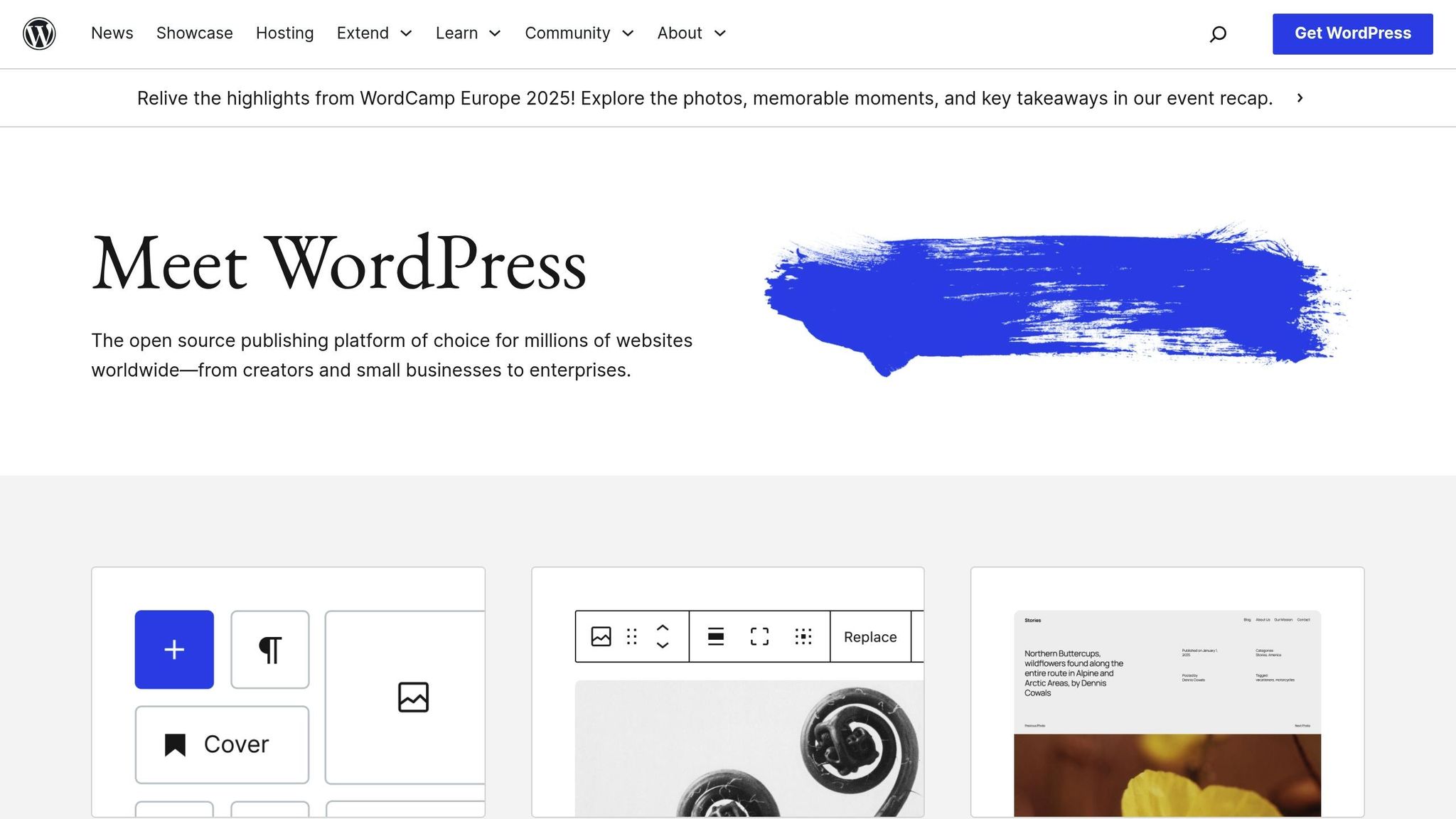
WooCommerce is a major player in the e-commerce world, powering over 5 million online stores and claiming more than 28% of the online store market. This popularity has driven 3PL providers to develop specialized solutions tailored for WooCommerce users. By using plugins or extensions, these integrations connect your WooCommerce store directly to a 3PL's system, ensuring efficient fulfillment operations.
Take J&J USA, for example, which offers solutions specifically designed for WooCommerce users. They highlight:
"Our WooCommerce fulfillment services are designed to integrate with your WordPress store, providing efficient order processing, real-time inventory management, and reliable shipping solutions."
This kind of scalability ensures that as your business grows, your fulfillment process remains seamless - a key benefit of 3PL integrations.
US Market Advantages
For businesses operating in the United States, WooCommerce integrations offer features tailored to the local market. These integrations work seamlessly with major US carriers like USPS, UPS, FedEx, and DHL. They enable automated label printing, real-time shipping rate calculations, and advanced tracking - all critical for managing shipping costs, which typically make up 88% of distribution expenses.
Additionally, tools like TaxJar simplify sales tax management by automating calculations, tracking nexus obligations, and generating detailed reports. Together, these shipping and tax tools provide the foundation for robust analytics, enabling smarter logistics decisions.
Advanced Analytics and Decision-Making
Modern WooCommerce-3PL integrations go beyond basic functionality, offering advanced business intelligence tools. For example, SHIPHYPE’s platform provides features such as:
"With our 3PL for WooCommerce, you can easily track inventory levels, monitor shipment progress, and even return products from any store location. Our dashboard also provides detailed performance and satisfaction reports so that you can make data-driven decisions to optimize your operations."
Top 3PL providers boast shipment and order accuracy rates exceeding 99.9%. This level of precision, combined with actionable insights from analytics, allows WordPress store owners to refine inventory management, shipping strategies, and customer service as their businesses expand.
As your WooCommerce store scales, these integrations help handle growing order volumes, seasonal demand spikes, and new market opportunities - all while maintaining top-notch service accuracy and customer satisfaction.
3. Amazon Marketplace Integration
Amazon Marketplace integration streamlines multi-channel fulfillment by tapping into Amazon's extensive logistics network. With Amazon Multi-Channel Fulfillment (MCF), businesses can process orders from various sales channels - not just Amazon.com - using Amazon's fulfillment infrastructure. This approach helps unify inventory and shipping processes, creating a more efficient system.
Simplifying Multi-Channel Operations
MCF serves as a third-party logistics (3PL) solution, pooling inventory for all sales channels, which eliminates the hassle of managing separate fulfillment systems. As Amazon describes it:
"MCF is a third-party logistics (3PL) solution that enables you to leverage Amazon's fulfillment network and team of experts to pick, pack, ship, and deliver your customer orders from off-Amazon sales channels."
The system automates the entire fulfillment process - from checkout to delivery - while offering free, unbranded packaging.
Meeting US Marketplace Requirements
For brands selling across multiple US platforms, MCF helps meet specific marketplace policies. For example, Walmart orders are shipped in unbranded boxes and use non-Amazon carriers to comply with Walmart's requirements. Additionally, Amazon has waived the 5% surcharge for blocking Amazon Logistics until January 14, 2026.
Setting up integration requires developer registration with OAuth 2.0 support and demonstrating 3PL functionalities like rate acquisition, shipment purchasing, cancellations, and tracking.
Proven Performance Results
MCF delivers strong performance, including over 97% on-time deliveries, available seven days a week, and a 99.8% undamaged delivery rate. Real-world examples showcase its impact:
-
Wyze: Reduced click-to-delivery times by over 50%. Rob Johnson, Principal Ecommerce Leader at Wyze, shared:
"When we worked with MCF, we were very happy with what that did for us in terms of fulfillment times. We've been able to half the time between the click to delivery of our products."
- Poppi: Cut fulfillment costs by 30% by integrating its Shopify website with MCF.
- Fishers Finery: Boosted off-Amazon ecommerce revenue by 988% over 10 years using MCF as its primary 3PL.
- NXTRND: Increased website sales by 8.9% by displaying Amazon's fast delivery estimates directly on product pages.
These examples highlight how MCF can significantly improve fulfillment efficiency and customer satisfaction.
Strategic Business Impact
The benefits of Amazon Marketplace integration extend beyond operational efficiency. Sellers using both Fulfilled by Amazon (FBA) and MCF report 38% higher revenue, 24% better inventory turnover, and 13% fewer out-of-stock issues. For new sellers, Amazon offers a 10% discount on fulfillment costs for the first 100 units shipped through MCF.
Additionally, the platform integrates seamlessly with major eCommerce platforms like Shopify, eBay, and BigCommerce, making it easier for businesses to scale their operations without compromising on fulfillment standards .
This integration is a powerful tool for brands aiming to grow their multi-channel operations while maintaining reliable and efficient fulfillment processes.
4. Shipping Carrier Integrations
Integrating with top U.S. carriers like USPS, FedEx, and UPS has completely transformed how shipping is handled within 3PL systems. These connections bring all carrier options into one place, eliminating the need to juggle multiple portals or rely on manual processes.
Streamlined Rate Shopping Capabilities
With built-in rate shopping tools, businesses can instantly compare shipping costs across carriers, saving time and money. Instead of manually checking each carrier’s website, these tools do the work for you. As Buoyancy Software puts it:
"Multi-carrier shipping software allows businesses to integrate with multiple carriers like FedEx, UPS, and USPS within a single platform. This flexibility ensures that you can choose the most cost-effective and reliable shipping option for every order based on weight, delivery speed, destination, and service level."
These tools can help retailers cut shipping costs by 2% to 20%, which is a big win in the face of rising shipping expenses. Plus, the rate comparisons feed directly into automated workflows, making the entire process more efficient.
Automated Label Generation and Compliance
Carrier integrations also make label generation a breeze while ensuring compliance with shipping regulations. For instance, SPS Commerce saw a 90% reduction in label printing time after integrating with the ShipStation API. These systems handle everything from creating shipping labels to generating customs documents, all while validating addresses to avoid delivery issues. On top of that, users gain access to discounted carrier rates.
Real-Time Tracking and Customer Communication
Real-time tracking features keep customers informed and reduce frustration. If a carrier like FedEx encounters delays, the system automatically updates customers with tracking maps, delay details, and status notifications. This proactive communication reduces customer service inquiries by 73%, as fewer customers feel the need to reach out for updates. In fact, 88% of customers say real-time tracking is essential for a good experience, and 70% of American shoppers prefer checking tracking updates over contacting support when shipments are delayed. This tracking capability not only keeps customers in the loop but also supports smarter logistics decisions.
Carrier Selection Strategy
Each carrier has its strengths. USPS is perfect for lightweight packages and offers PO Box delivery, UPS provides dependable domestic and international shipping at moderate costs, and FedEx excels in express shipping for urgent deliveries. Advanced systems analyze factors like weight, destination, and delivery speed to pick the best carrier for each shipment. This is especially important when you consider that 48% of U.S. shoppers abandon carts due to high shipping costs. By selecting the right carrier, businesses can improve fulfillment efficiency and keep customers happy.
These carrier integrations simplify operations for 3PL systems, cutting down on complexity while boosting cost savings and delivery performance for businesses and their customers alike.
5. EDI (Electronic Data Interchange) Integration
For eCommerce brands looking to streamline fulfillment with 3PL providers, EDI (Electronic Data Interchange) plays a key role. It acts as a digital link between systems, automating the exchange of essential data. Documents like purchase orders, inventory updates, and shipping confirmations are converted into standardized formats (such as ANSI X12 or EDIFACT), ensuring different platforms can communicate effectively. This automation has become a cornerstone of modern 3PL operations.
In 2019, EDI managed 78.4% - or $7 trillion - of all B2B electronic sales. For eCommerce businesses, this technology eliminates delays caused by manual processes, replacing them with fast, paperless workflows.
Automated Order Processing and Inventory Management
With EDI integration, the moment an order is placed, standardized data is sent directly to the 3PL provider. This enables real-time order processing and inventory updates, ensuring stock levels remain accurate across all sales channels. Tasks like handling purchase orders, shipping notices, and inventory management are automated, significantly reducing errors and speeding up operations. By keeping data synchronized across platforms, EDI ensures smooth collaboration between eCommerce brands and their 3PL partners.
Compliance with U.S. Business Standards
EDI systems also help businesses meet important industry standards and regulations, which are crucial for logistics in the U.S. For example, EDI supports standards like GS1 and UCC-128 labeling, which are essential for seamless operations across state lines and international borders. This is especially critical when handling regulated products or working with major retailers that demand strict EDI compliance. A global retailer, for instance, uses EDI to automate shipping notices and purchase orders with suppliers and 3PL partners, reducing manual entry errors. Real-time tracking updates further enhance customer service by enabling quicker responses to inquiries.
Cost Savings and Operational Efficiency
EDI integration offers direct financial benefits through automation. By speeding up transaction cycles, it allows for faster order processing and payment reconciliation, which improves cash flow. Additionally, EDI reduces costly mistakes - like shipping incorrect quantities or products - by minimizing human error. This not only lowers operational costs but also protects customer satisfaction and loyalty.
Implementation Considerations
Implementing EDI requires thorough planning and collaboration. Typically, the 3PL provider takes the lead in managing the integration, with clear roles and expectations established upfront. Cloud-based EDI platforms are particularly appealing for growing eCommerce businesses, as they provide scalability without requiring heavy IT investments. These platforms can handle increasing transaction volumes with ease, setting the stage for efficient 3PL operations once the system is in place.
sbb-itb-eb0f906
6. Real-Time Inventory and Order Management Platforms
Real-time inventory and order management platforms act as the backbone connecting eCommerce businesses with their 3PL providers. These platforms provide live updates on stock movement, order processing, and shipping status, creating a seamless flow of information that powers efficient operations and supports the benefits outlined below.
"Real-time tracking in 3PL refers to the use of technology - such as GPS, RFID, barcode scanning, and cloud-based warehouse management systems (WMS) - to provide live updates on inventory movement, order fulfillment, and shipment status." – Your Logistics
By integrating these systems, companies have seen inventory accuracy improve by 20% to 30%, stockouts drop by up to 50%, and demand forecasting accuracy increase by 73%.
Seamless Data Synchronization Across Multiple Locations
Modern 3PL providers rely on inventory systems that offer real-time visibility into stock levels across warehouses and distribution centers. Cloud-based solutions ensure that inventory data is automatically updated and synchronized across all locations and platforms.
This integration can reduce order cycle times by 15% to 30% and cut logistics costs by an average of 13%. Additionally, these systems automate tracking and error detection, significantly reducing human mistakes.
Enhanced Customer Experience Through Accurate Information
Real-time inventory platforms also elevate the customer experience by providing accurate, up-to-date order information. When inventory data is synchronized across all sales channels, customers can trust the stock availability they see online or in stores.
"With real-time data, businesses can maintain more accurate inventory records, leading to better decision-making and fewer discrepancies between physical and recorded inventory." – Nautical Manufacturing & Fulfillment
This accuracy translates into measurable benefits: businesses using 3PL services report a 10% to 20% increase in customer satisfaction scores, and retailers see up to 40% higher in-store conversion rates thanks to features like buy-online-pickup-in-store (BOPIS).
Real-World Success Stories
The impact of real-time inventory systems is clear in real-world examples. In 2023, Adidas partnered with CEVA Logistics to improve its inventory management. CEVA integrated advanced warehousing solutions with real-time tracking into Adidas's ERP system. The results? A 20% boost in inventory accuracy, a 15% reduction in stockouts during peak seasons, and a 10% cut in logistics costs.
Similarly, Odaje, a French footwear brand, connected data from 16 physical stores and its online shop using real-time inventory management. This integration led to a 6% increase in conversion rates and a 25% jump in international sales.
Key Features for Maximum Impact
When choosing a real-time inventory platform, look for features that simplify operations and provide actionable insights:
- Automated Order Processing: Streamlines the journey from order entry to fulfillment.
- Multi-Channel Synchronization: Combines orders from different platforms into one dashboard.
- Advanced Analytics: Offers insights into key performance metrics.
To illustrate the difference, here's how traditional tracking compares to real-time tracking:
| Feature | Traditional Tracking | Real-Time Tracking |
|---|---|---|
| Update Frequency | Delayed or periodic | Continuous, live updates |
| Data Access | Manual checks, limited | Instant dashboard access |
| Inventory Accuracy | Periodic updates | Near-perfect with automation |
| Customer Experience | Generic status updates | Precise location and ETA |
| Issue Resolution | Reactive | Proactive issue flagging |
Implementation Best Practices
To make the most of these platforms, partner with a 3PL provider that offers robust real-time reporting tools and dashboards. Ensure your system integrates directly with the 3PL's platform to enable smooth data sharing and efficient order processing.
Automate the transfer of critical data - like stock levels, order updates, and shipping details - between your systems and the 3PL's platform. Test all data flows before going live to ensure everything works as intended.
The payoff is undeniable: better accuracy, lower costs, and happier customers. With 90% of companies using 3PLs reporting improved scalability in their supply chains, real-time inventory and order management platforms have become a must-have for competitive eCommerce operations.
7. Forthmatch Integration
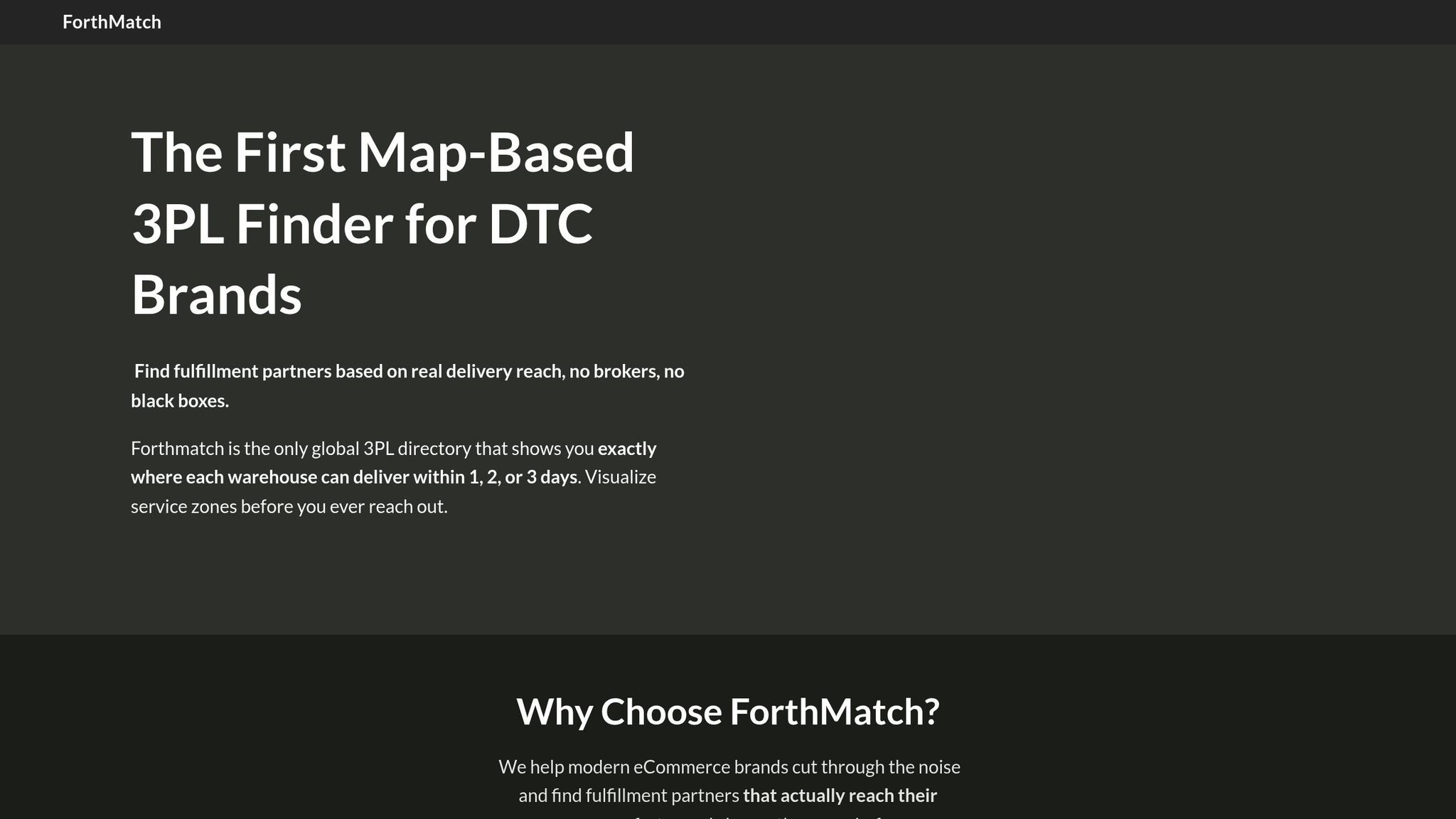
When it comes to streamlining fulfillment, picking the right 3PL partner is just as important as having the right technology. While technical integrations can simplify operations, finding the perfect match among 3PL providers remains a tough challenge for many eCommerce brands. That’s where Forthmatch steps in, offering a robust directory of over 150 verified 3PL providers tailored specifically for direct-to-consumer brands in the U.S. market.
"We help modern eCommerce brands filter through options and find fulfillment partners that actually reach their customers, faster and clearer than ever before." – Forthmatch
Visual Service Area Mapping
One of Forthmatch's standout features is its real-time service area mapping. Using advanced isochrone and isodistance analysis, it visually displays the delivery reach of each 3PL warehouse. You can see exactly how far each warehouse can deliver, measured in miles and delivery times - whether it’s same-day, next-day, or two-day delivery. This eliminates guesswork and empowers you to make informed decisions about which providers are best suited to your key markets.
Smart Filtering and Search Tools
Forthmatch simplifies the search for the right 3PL partner with its intuitive filtering and search capabilities. You can filter by factors like technology, order volume, shipping zones, platform integrations, and even category specialties. Whether you’re selling electronics, clothing, or perishable goods, you can quickly find providers that align with your needs. Plus, the platform supports search-by-region and product type, enabling you to identify 3PLs that integrate seamlessly with platforms like Shopify, WooCommerce, or Amazon.
Direct Connections Without Middlemen
Forthmatch cuts out the middlemen, letting you connect with providers directly. Gone are the days of juggling endless spreadsheets and email threads. This direct approach not only speeds up the selection process but also encourages open and transparent pricing discussions. By reducing manual steps, Forthmatch aligns perfectly with the goal of simplifying fulfillment operations.
Advanced Tools for Strategic Planning
Forthmatch is constantly evolving to offer even more value. Soon, its reverse match-by-region feature will allow you to pinpoint 3PLs based on specific delivery timeframes, factoring in distance, logistics constraints, and shipping methods. Additionally, planned updates like reviews and reputation scoring - powered by sentiment analysis from trusted sources - will provide deeper insights into provider performance. These features complement its existing tools, creating a comprehensive solution for selecting and managing 3PL partnerships.
Tailored for Modern eCommerce
Forthmatch is built with direct-to-consumer brands and growing businesses in mind, offering the speed, scalability, and precision needed to thrive in today’s eCommerce landscape.
"With real maps and verified capabilities, Forthmatch helps you pick your next 3PL with confidence and speed." – Forthmatch
For eCommerce brands looking to fine-tune their fulfillment strategies, Forthmatch provides a data-driven platform that connects you with 3PL providers who have the geographic reach, technical know-how, and specialized expertise to support your growth goals. It’s a tool designed to make fulfillment smarter, faster, and more efficient.
Comparison Table
After carefully reviewing various integration options, it's clear that selecting the right 3PL tech integration is crucial for aligning with your business, platform, and growth objectives. Below is a side-by-side comparison to help pinpoint which option best suits your operational needs.
| Integration Type | Key Benefits | Supported Platforms | US-Specific Features | Typical Use Cases |
|---|---|---|---|---|
| Shopify Integration | Real-time order sync, automated inventory updates, seamless checkout experience | Shopify, Shopify Plus | USPS, UPS, FedEx rate calculation, US tax compliance, domestic shipping zones | DTC brands, subscription boxes, fashion retailers, small to medium businesses |
| WooCommerce Integration | Open-source flexibility, custom shipping rules, WordPress ecosystem compatibility | WooCommerce, WordPress | US postal codes validation, state tax integration, domestic carrier APIs | Tech-savvy businesses, custom storefronts, B2B companies, niche markets |
| Amazon Marketplace Integration | FBA prep services, Seller Central sync, multi-channel inventory management | Amazon Seller Central, Amazon Vendor Central | Amazon Prime eligibility, US fulfillment center distribution, FBA labeling compliance | Amazon sellers, multi-channel retailers, brands scaling on Amazon |
| Shipping Carrier Integrations | Direct carrier rates, label printing, tracking automation, delivery confirmation | Universal API support | USPS Priority Mail, UPS Ground, FedEx Express, regional carriers like OnTrac | High-volume shippers, businesses with specific delivery needs, cost-conscious brands |
| EDI Integration | Automated data exchange, enterprise-level connectivity, bulk order processing | SPS Commerce, Commerce Hub, AS2 networks | Walmart, Target, Home Depot connections, US retail compliance standards | Large retailers, wholesale operations, enterprise brands, big-box store suppliers |
| Real-Time Inventory Platforms | Live stock updates, demand forecasting, multi-location visibility, backorder prevention | NetSuite, Salesforce, QuickBooks Online, custom ERPs | US warehouse management, seasonal demand patterns, cross-docking capabilities | Growing businesses, multi-location brands, inventory-heavy operations |
| Forthmatch Integration | 3PL discovery and comparison, service area mapping, direct provider connections | Directory of 150+ verified 3PLs supporting all major platforms | US-focused provider network, delivery zone visualization, regional specialization matching | Brands seeking new 3PL partners, businesses expanding geographically, companies comparing fulfillment options |
This table provides a quick overview of each integration's benefits and applications, helping you make an informed decision. Did you know that 90% of US Fortune 500 companies partner with a 3PL? This underscores the importance of choosing an integration strategy that aligns with your business goals.
When it comes to costs, there's a wide range to consider. For example, platform-native integrations like Shopify often have lower upfront costs, while EDI solutions require a higher initial investment but can deliver long-term savings for businesses handling large volumes. Scalability also varies: Shopify and WooCommerce are ideal for managing hundreds to thousands of orders per month, whereas EDI and enterprise platforms are designed for tens of thousands.
"Choosing a 3PL partner is not just about cost; it's about finding a provider that can deliver customized solutions, scalability, and a commitment to continuous improvement." - Jerry Y
Many successful eCommerce brands use a combination of integrations to maximize efficiency. For instance, they might rely on Shopify or WooCommerce for core operations, supplement with direct carrier connections to secure better rates, and use tools like Forthmatch to refine their 3PL partnerships as they expand. Aligning your current order volume with future growth projections ensures your integration strategy will support both immediate needs and long-term plans.
Conclusion
Embracing 3PL tech integrations marks a pivotal change in how US eCommerce brands handle fulfillment and elevate customer satisfaction. It’s no surprise that 90% of Fortune 500 companies already collaborate with 3PLs to streamline their operations and improve efficiency. Now is the time to determine which integration aligns best with your market demands and growth plans.
The seven integration types discussed here can significantly impact your bottom line. For instance, outsourcing warehousing to a 3PL can lead to a 15–30% reduction in logistics costs. Similarly, businesses utilizing advanced inventory management systems are 35% more likely to minimize backorders and enhance customer satisfaction. And here’s a critical insight: 69% of shoppers will abandon a brand after just one delivery failure. These stats highlight the importance of seamless fulfillment in today’s competitive market.
"Integrated fulfillment is not just about improving operational efficiency; it's about creating a seamless customer experience that drives business growth." - One World Direct
The US market offers unique opportunities for brands that make thoughtful integration decisions. Whether you’re processing Shopify orders, managing enterprise-level EDI connections, or leveraging Amazon’s fulfillment network, aligning with top platforms and carriers can simplify operations and reduce costly mistakes. This alignment helps you achieve immediate operational improvements while setting the stage for sustained growth.
To get started, identify your logistics challenges and pair them with the right integration strategy. Keep a close eye on metrics like order accuracy, delivery speed, and customer feedback. Establish clear communication with potential 3PL providers and set measurable KPIs that reflect your business objectives. It’s worth noting that over 85% of customers are willing to pay a 25% premium for superior service, making these integrations a direct route to boosting revenue.
With the global 3PL market projected to hit $2.33 trillion by 2032, early adopters stand to gain a competitive edge. The choices you make today will determine whether you seize new opportunities or fall behind more agile competitors. By strategically adopting the right integrations, you can position your business to thrive in this expanding market.
"Shipping integrations automate order processing, enable real-time tracking, and reduce bottlenecks." - XPDEL
Take a close look at your current platform capabilities, evaluate your carrier partnerships, and implement integrations that address both your immediate needs and long-term scalability. These seven integration types provide the framework for delivering flawless fulfillment and ensuring your business stays ahead of the curve.
FAQs
How does integrating Shopify with a 3PL provider benefit my eCommerce business?
Integrating Shopify with a 3PL provider can take your eCommerce game to the next level by automating essential tasks. This integration keeps your inventory updated in real-time, speeds up order processing, and boosts shipping accuracy - all while minimizing the chances of manual errors.
What’s more, this connection enhances the customer experience. It allows you to offer precise tracking updates and quicker delivery times, which customers love. By simplifying your fulfillment process, you free up time to concentrate on growing your business while keeping your customers happy.
How do real-time inventory platforms benefit eCommerce brands when working with 3PL providers?
Integrating real-time inventory platforms with third-party logistics (3PL) providers can be a game-changer for eCommerce brands. One major advantage is improved inventory accuracy. With up-to-date stock levels, businesses can avoid the headaches of overselling or running out of stock, keeping operations smooth and customers happy.
Another big plus? Better supply chain visibility. Real-time insights into inventory movement allow businesses to make quicker, more informed decisions. This clarity can be a huge boost when navigating the fast-paced world of eCommerce.
On top of that, real-time tracking can cut down on operational costs by reducing errors and simplifying workflows. Faster, more efficient order fulfillment is another perk, which translates to quicker deliveries and happier customers. In a competitive market, these tools help businesses stay sharp and adaptable.
Why is selecting the right 3PL partner essential for growing your eCommerce business, and how does Forthmatch make this process easier?
Why Choosing the Right 3PL Partner Matters
Picking the right third-party logistics (3PL) partner can make or break your eCommerce business. A dependable 3PL ensures smooth order fulfillment, reduces shipping delays, and sets the stage for long-term growth. By handling logistics seamlessly, they free you up to concentrate on what you do best - like marketing your brand and connecting with customers.
This is where Forthmatch steps in to make life easier. They link eCommerce brands with trustworthy 3PL providers that fit their specific needs. With Forthmatch, you can simplify the decision-making process, fine-tune your logistics, and build a fulfillment strategy that’s both scalable and cost-efficient - all tailored to your business goals.
